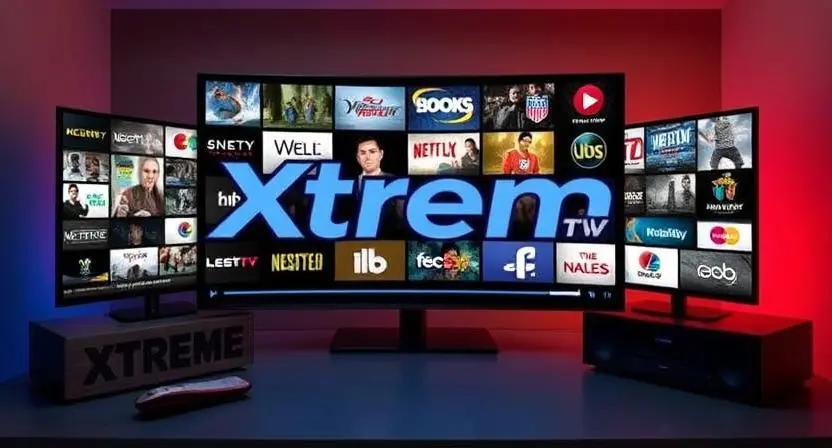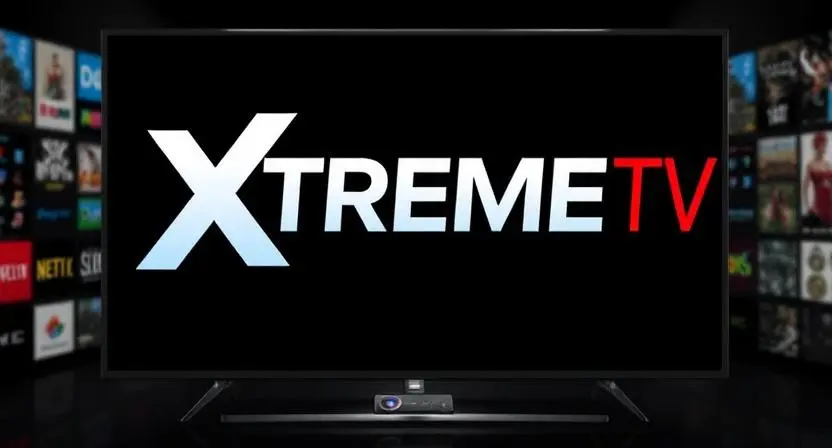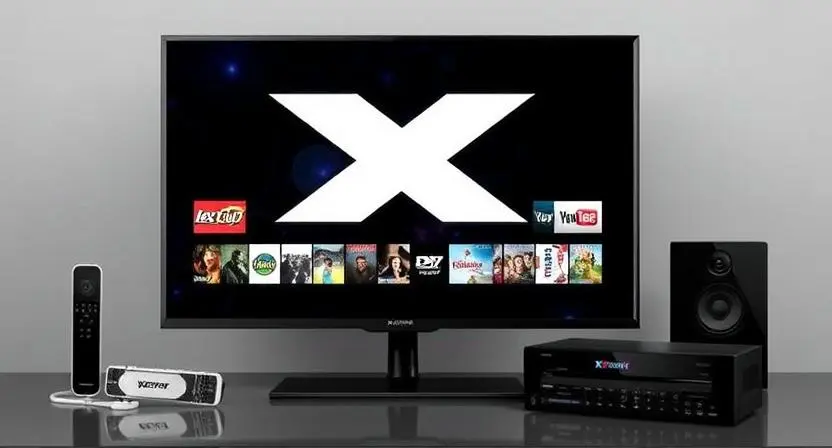Table of Contents
Introduction
Xtreme TV has emerged as a prominent name in the world of Internet Protocol Television (IPTV), appealing to cord-cutters and international viewers with promises of extensive channel lineups and on-demand libraries. Over recent years, streaming via IP networks has reshaped how audiences consume video content, moving away from traditional cable or satellite models toward more flexible internet-based delivery (techtarget.com, en.wikipedia.org).

As consumers seek cost-effective, device-agnostic solutions, services like Xtreme TV—often referred to in reviews and forums under names such as Xtreme HD IPTV—garner attention for offering thousands of live channels and VOD options at competitive prices (xtremehdiptv.io, firesticktricks.com). This article will address the search intent behind “xtreme tv” by defining its core technology, outlining its features and benefits, comparing it to alternatives, analyzing legality and safety,
guiding readers through setup, and answering common questions. The aim is to provide comprehensive, authoritative insights so that readers can make an informed decision about whether Xtreme TV aligns with their viewing needs and risk tolerance. Throughout this piece, “xtreme tv” will be mentioned naturally in introductions, section headings, and body text to reinforce relevance and meet SEO requirements. Later sections delve into technical underpinnings of IPTV, device
compatibility, pricing tiers, and practical steps for installation, ensuring readers understand both potential advantages and caveats. By structuring content logically and using clear subheadings, the article ensures easy navigation for readers and search engines alike. Statistics and third-party reviews will be cited from reputable sources to build trust and authority.
An FAQ section is included to capture featured-snippet opportunities, addressing direct user queries with concise answers. Finally, a balanced pros-and-cons summary and conclusion will help readers decide if Xtreme TV is suitable for their streaming lifestyle.
What Is Xtreme TV?
Understanding Xtreme TV and How It Works
Xtreme TV operates on IPTV technology, delivering television programming and video content over IP networks instead of traditional broadcast, cable, or satellite systems, enabling on-demand streaming and live broadcasts via internet protocols (techtarget.com, amiralabs.com). The service typically requires a subscription that grants access to a proprietary or third-party app which uses M3U playlists or dedicated streaming protocols (e.g., HLS) to fetch channels and VOD content from
remote servers, leveraging adaptive bitrate streaming for smoother playback across varying network conditions (vitec.com, uscreen.tv). Behind the scenes, Xtreme TV providers maintain global server infrastructure or reseller networks to deliver
thousands of channels spanning sports, news, entertainment, and international feeds, often utilizing anti-freeze or buffering-reduction technologies to optimize user experience (firesticktricks.com). Subscriptions usually include electronic program guides (EPG) that aggregate scheduling data from multiple sources to display real-time listings, enabling users to browse upcoming broadcasts and catch up on missed shows. The core appeal lies in portability and flexibility—users can stream on smartphones, smart TVs, set-top boxes, and desktop apps without fixed long-term contracts typical of cable providers.
However, because many IPTV offerings operate in legal gray areas, it’s crucial for users to understand service legitimacy and privacy considerations, such as routing traffic through VPNs to protect data and avoid ISP throttling or monitoring (xtremehdiptv.io). Overall, Xtreme TV harnesses established IPTV protocols to offer broad channel selection and on-demand libraries at lower price points than many traditional and OTT counterparts, albeit with trade-offs in content licensing transparency and potential stability risks.
Devices Compatible with Xtreme TV
Xtreme TV compatibility spans a wide variety of devices, reflecting the need for versatility in modern streaming environments. Most providers offer Android-based apps or APK files that install on Android TVs, Android TV boxes, Fire TV Stick devices, and Android smartphones/tablets, enabling native playback without additional players
(xtremehdiptv.in.net). For iOS devices, some services provide dedicated iOS apps or require manual configuration in IPTV player apps such as IPTV Smarters or GSE Smart IPTV. On desktop platforms, Windows and macOS users may use VLC or third-party IPTV players to load playlist URLs or app packages when available. Many Smart TV ecosystems (Samsung Tizen, LG WebOS) permit installation of IPTV apps directly or via sideloading methods, while Chromecast or AirPlay
functionality can mirror mobile or desktop streams to TV screens. Gaming consoles and Linux-based systems are sometimes supported through Kodi add-ons configured with Xtreme TV playlist links. Regardless of device, stable broadband connection and correct app configuration are imperative for buffer-free performance. Some providers also support multiple concurrent streams under a single subscription, allowing users to share access across household devices while respecting
connection limits. Ultimately, Xtreme TV’s device flexibility underpins its appeal to users seeking seamless viewing across varied hardware environments without expensive set-top boxes.
Xtreme TV Features and Benefits
Channel Variety and Global Access
One of Xtreme TV’s primary selling points is its extensive channel lineup, often boasting over 20,000 live TV channels and tens of thousands of VOD titles covering movies, series, sports, news, and special-interest programming (xtremehdiptv.io, firesticktricks.com). Providers aggregate feeds from multiple regions, enabling subscribers to access local channels from the US, UK, Canada, Europe, Asia, and beyond, appealing to expatriates and international audiences craving home-country content. Many services include premium sports and PPV event streams, though availability can vary and may involve
additional charges or temporary access tokens. Channel categories typically cover general entertainment, lifestyle, kids, documentaries, music, and adult content, with multi-language support enhancing user choice. Live TV in HD and 4K resolution is promoted, subject to user bandwidth; anti-freeze or buffering-optimization features aim to maintain stable
playback even under variable network conditions (troypoint.com). However, actual channel availability may fluctuate based on provider agreements and server load; occasional downtime reports underscore the importance of 24/7 customer support. Overall, the vast variety and global reach position Xtreme TV as a one-stop solution for diverse viewing preferences at competitive pricing relative to multiple separate streaming subscriptions.
VOD & Catch-Up TV Capabilities

Beyond live channels, Xtreme TV often includes robust Video-on-Demand (VOD) libraries featuring movies, TV series, documentaries, and specials, sometimes numbering upwards of 40,000 titles (xtremehdiptv.io, firesticktricks.com). Users benefit from the convenience of browsing catalogs via interactive EPG or separate VOD menus, selecting content for
immediate playback. Catch-up functionality may allow rewinding or restarting live broadcasts within a certain window, subject to provider support and licensing constraints. Some implementations integrate DVR-like recording features, letting users schedule recordings of favorite shows, although storage may be limited or controlled server-side. The VOD section
can include search filters by genre, year, or language, enhancing discoverability. While the promise of extensive libraries is appealing, actual content freshness and legal licensing may vary; some titles might be unofficial streams or subject to
regional restrictions. Providers sometimes update VOD catalogs regularly, but users should verify the legitimacy of newly added content. In sum, the VOD and catch-up offerings augment live streaming by giving subscribers flexible viewing choices, aligning with modern consumption habits for on-demand entertainment.
User Interface and Streaming Quality
Xtreme TV user interfaces range from proprietary apps with custom skins to compatibility with third-party IPTV players offering standardized layouts. Well-designed interfaces feature intuitive navigation menus, clear EPG displays, and easy switching between live channels and VOD sections (firesticktricks.com). Many services tout optimized streaming quality with support for adaptive bitrate streaming to adjust resolution based on real-time bandwidth, thereby minimizing buffering.
Claims of HD and 4K streams depend on server capacity and user internet speed; some providers implement CDN or distributed servers to reduce latency and improve uptime (troypoint.com). Anti-freeze technologies or optimized buffering algorithms aim to enhance stability during peak hours. Customization options may include favorites lists, parental controls, and subtitle settings. However, user experience can suffer if servers are overloaded or network conditions deteriorate; thus,
reliable customer support and transparent uptime statistics are important. Overall, a responsive, user-friendly interface combined with robust streaming infrastructure enhances the appeal of Xtreme TV, but performance may vary across providers and regions.
Xtreme TV Pricing and Subscription Plans
Monthly, Quarterly, and Yearly Options
Xtreme TV subscription plans typically offer tiered durations—monthly, quarterly, semi-annual, annual, and sometimes lifetime options—catering to different commitment levels and budgets (xtremehdiptv.io, xtremehdiptv.org). Pricing often scales with the number of simultaneous device connections permitted, such as one, two, four, or five concurrent streams
under a single account. For example, basic plans may start around $15–$16 per month for one connection, while multi-device or longer-term subscriptions yield discounts per month when billed quarterly or annually (troypoint.com). Lifetime plans might appear attractive but warrant caution regarding long-term service continuity and provider reliability. Trial offers
or 24-hour test periods are sometimes available to assess service quality before full commitment, with clear policies on trial limitations and refund eligibility (often none after activation) (xtremehdiptv.in.net). Prospective subscribers should compare cost-per-channel metrics versus alternatives like individual OTT services or cable bundles, factoring in potential legal and
support risks. Transparent pricing pages and responsive sales channels enhance trust, while opaque or drastically low-priced plans may signal unstable offerings. Ultimately, selecting a plan involves balancing budget, device usage patterns, and confidence in provider longevity.
Payment Methods and Accessibility
Xtreme TV providers generally accept multiple payment methods to accommodate global subscribers, including credit/debit cards, PayPal, cryptocurrency options like Bitcoin for increased privacy, and occasionally gift cards or e-wallet services (xtremehdiptv.io). Anonymous payment via crypto may appeal to privacy-conscious users wary of linking streaming
subscriptions to personal financial data. Payment gateways should be secure (HTTPS, PCI-compliant) to protect transaction data. Automatic recurring billing can simplify renewals but requires clear cancellation procedures to avoid unintended charges. Accessibility of service regions depends on provider server coverage; some may block certain countries or enforce regional restrictions due to licensing, while VPN usage might circumvent geoblocks at the user’s risk. Multi-currency
pricing or localized payment options can improve affordability for international audiences. Customer support channels (email, live chat, ticketing) play a role if payment issues arise. Overall, diverse and secure payment options, along with transparent billing terms, contribute to a smoother subscription experience for Xtreme TV users.
Xtreme TV vs Competitors
How Xtreme TV Compares to Traditional Cable

Compared to traditional cable TV, Xtreme TV offers flexibility in device usage, eliminating the need for physical set-top boxes and long-term contracts (uscreen.tv). Users can access live channels and VOD content on smartphones, tablets, smart TVs, and computers via internet connections, making viewing more portable and adaptable to travel or relocation
(firesticktricks.com). Pricing for Xtreme TV subscriptions often undercuts combined cable and OTT bundles, especially for international channels not typically included in standard cable packages. However, cable providers offer regulated licensing, content reliability, emergency broadcast capabilities, and customer protections not guaranteed with IPTV services.
Additionally, technical support and service-level agreements for cable are often more robust than those from smaller IPTV operations. For viewers prioritizing licensed, stable, and fully legal content delivery with local broadcast integration, traditional cable or established OTT platforms may be preferable despite higher costs. Conversely, viewers seeking
extensive international content and cost savings may opt for Xtreme TV while accepting potential risks.
Xtreme TV vs Other IPTV Services
Within the IPTV ecosystem, Xtreme TV competes with various third-party services such as IPTV Smarters-compatible providers, Helix IPTV, TiviMate-friendly subscriptions, and others frequently mentioned on forums and review sites (softwaretestinghelp.com). Compared to free or ad-supported IPTV apps, paid Xtreme TV subscriptions often promise
higher stability, more channels, and professional support. Against major OTT platforms (Netflix, Disney+, Hulu), Xtreme TV’s advantage lies in live international channels and PPV event coverage, albeit without guaranteed content licensing clarity. When contrasted with rival IPTV providers, factors include channel count, streaming quality (HD/4K), uptime
guarantees, customer service responsiveness, pricing tiers, and trial policies (troypoint.com). Some services differentiate via unique features like integrated DVR, multi-screen simultaneous streams, and advanced EPGs. Potential subscribers should consult recent reviews from reputable sites to compare uptime statistics, user feedback, and legal risk assessments before choosing Xtreme TV or alternatives.
Is Xtreme TV Legal and Safe to Use?
IPTV Legality: What You Need to Know
The legality of Xtreme TV hinges on how content rights are managed; many IPTV providers operate in a gray area by redistributing broadcast feeds without proper licensing (xtremehdiptv.io). While IPTV technology itself is legal and widely used by telecom operators and legitimate broadcasters, third-party services offering unauthorized access to premium
channels or copyrighted content may violate intellectual property laws in various jurisdictions (en.wikipedia.org, amiralabs.com). Users should research the provider’s licensing statements and consider local regulations; accessing unauthorized streams can carry legal consequences, including fines or service termination by ISPs. From a safety perspective, using a reputable VPN can protect privacy by encrypting traffic and preventing ISP throttling or monitoring,
though it does not legalize illicit streams (xtremehdiptv.io). Additionally, users must consider cybersecurity risks: unverified apps can contain malware or expose devices to vulnerabilities. Opting for officially licensed streaming services ensures
compliance and security but may limit access to certain international or specialized channels. Ultimately, consumers must weigh the appeal of extensive channel lineups against potential legal and security ramifications associated with Xtreme TV subscriptions.
How to Get Started with Xtreme TV
Installing Xtreme TV on Your Device
To begin with Xtreme TV, first confirm device compatibility and obtain the correct application package or playlist URL from the provider’s official communication channels (xtremehdiptv.in.net). For Android-based devices (Android TV,
Firestick), download and install the APK or app from the provider’s site or a trusted source, enabling “Unknown Sources” if sideloading is required. On iOS devices, follow provider instructions—often involving configuration profiles or installation via TestFlight or custom app stores—while ensuring device security settings permit installation. Smart TVs may require sideloading via USB or using third-party app stores if native apps are unavailable. For desktop platforms, use VLC or an
IPTV player to import the M3U playlist URL provided after subscription activation. Always verify the authenticity of download links to avoid malware; cross-check URL fingerprints or PGP signatures if offered. After installation, configure login credentials and EPG settings as per instructions, ensuring accurate time zone and regional settings for correct program
listings. Throughout this process, refer to step-by-step guides often published by providers to minimize setup errors.
Setting Up and Using Xtreme TV Efficiently

Once installed, launch the Xtreme TV app or IPTV player and input subscription credentials or playlist URLs as directed by the provider (xtremehdiptv.in.net). Navigate to the EPG section to load channel listings; allow sufficient time for the guide data to sync. Create favorites lists for quick access to preferred channels and adjust parental controls if available. Explore
VOD menus to verify on-demand content availability, using search and filter features to locate specific titles. Configure streaming quality settings if options exist, selecting adaptive or fixed bitrate modes based on network reliability. Utilize multi-screen or picture-in-picture features if supported to monitor multiple channels simultaneously. If DVR or recording
features are offered, schedule recordings of upcoming broadcasts; ensure server storage allowances are understood. Regularly update the app to benefit from bug fixes and feature enhancements. If buffering occurs, test internet speed and consider switching to a wired connection or different server within the app settings. For privacy, optionally route traffic
through a VPN with minimal performance impact. Finally, bookmark provider support pages or community forums for troubleshooting tips and stay informed about service updates.
Frequently Asked Questions (FAQ) About Xtreme TV
Is Xtreme TV free?
Xtreme TV is typically not free; access requires a paid subscription to unlock channel and VOD access, though some providers offer short trial periods (e.g., 24-hour testing) before payment commitment (xtremehdiptv.in.net).
Can I use Xtreme TV on multiple devices?
Most Xtreme TV plans allow multiple simultaneous connections—commonly one to five devices per subscription—subject to the chosen plan’s limits and provider policies (xtremehdiptv.org).
Does Xtreme TV include international channels?
Yes, one key appeal of Xtreme TV is access to a broad array of international channels spanning various regions and languages, catering to expatriates and global audiences (firesticktricks.com).
What if Xtreme TV stops working?
If streams fail or channels disappear, first check provider status pages or announcements; troubleshoot by verifying network connectivity, reloading EPG data, switching servers, updating the app, or contacting customer support for resolution (firesticktricks.com).
Is Xtreme TV legal?
Legality depends on licensing; many third-party IPTV services operate without proper rights, placing users in potential legal gray zones. Research provider claims and consider using licensed alternatives to avoid infringement risks (xtremehdiptv.io).
How do I improve streaming quality on Xtreme TV?
Improve quality by ensuring sufficient internet bandwidth, using wired connections, selecting optimal streaming settings, choosing servers geographically closer, and leveraging VPNs only if they do not degrade speed significantly (troypoint.com).
Pros and Cons of Xtreme TV
- Pros:
- Extensive channel lineup including international feeds, sports, news, and specialty content.
- Large VOD libraries with movies and series often included without extra fees.
- Device flexibility across Android, iOS, smart TVs, and desktop IPTV players.
- Competitive pricing relative to multiple OTT subscriptions and cable packages.
- Portable viewing without long-term contracts and easy cancellation or plan changes.
- Cons:
- Legal uncertainty due to possible unlicensed content distribution, exposing users to infringement risks.
- Potential instability or downtime if provider lacks robust infrastructure or faces legal takedown actions.
- Security concerns from unofficial apps or malicious links if installation sources are not verified.
- Variable streaming quality depending on server load, network conditions, and geographic location.
- Limited customer protections (refund policies often strict) and reliance on provider honesty.
Conclusion
In summary, Xtreme TV represents a flexible IPTV-based streaming solution offering vast channel selections and on-demand content at competitive price points, appealing especially to cord-cutters and international viewers seeking diverse programming (xtremehdiptv.io, firesticktricks.com). The service leverages IPTV technology—delivering TV over internet
protocols—to provide live channels, VOD libraries, EPG integration, and multi-device compatibility, often boasting HD/4K quality with buffering-optimization features (techtarget.com, troypoint.com). Subscription plans vary by duration and concurrent connections, with payment options including credit cards, PayPal, and cryptocurrencies to accommodate privacy preferences. However, users must carefully assess legal and safety considerations: many providers operate in licensing grey zones, potentially exposing subscribers to copyright infringement issues or unstable service continuity (xtremehdiptv.io).
Installing and configuring Xtreme TV requires attention to authentic sources, correct EPG setup, and optional VPN use for privacy. Comparing Xtreme TV to traditional cable and other IPTV services reveals trade-offs between cost savings and content legitimacy, with established OTT platforms offering more secure licensing but lacking certain international feeds. Ultimately, “xtreme tv” may suit tech-savvy users prioritizing extensive global channels and budget-friendly streaming,
provided they accept associated risks and take precautions. Prospective subscribers should research provider reputations through recent reviews, verify setup guides, and decide based on personal viewing habits and legal comfort. By following the guidance herein, readers can navigate the complexities of Xtreme TV to determine if it aligns with their streaming goals and risk tolerance

One Response